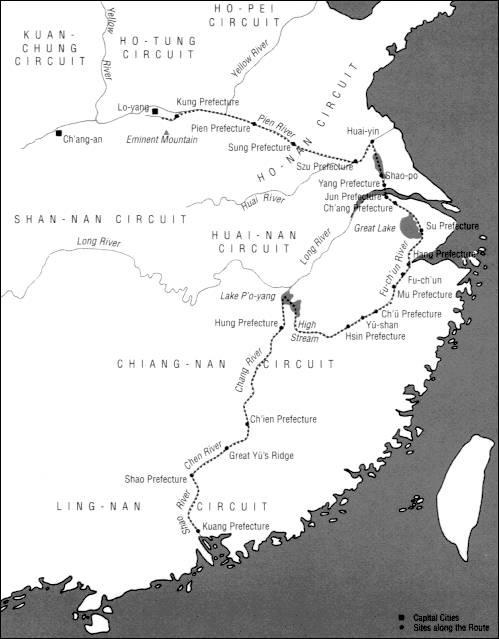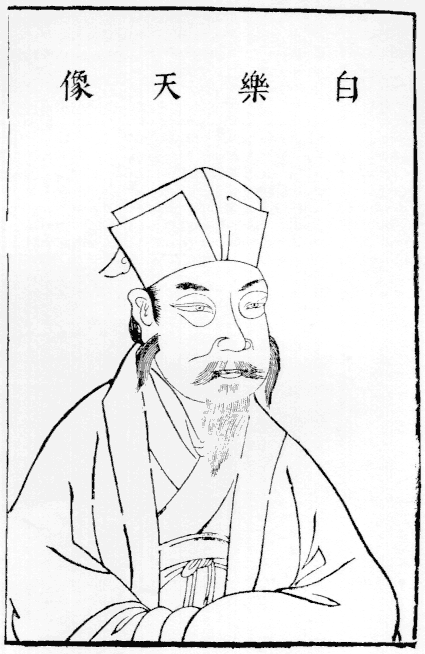12—
Li Ao (772–836)


4.
Li Ao's Route in Diary of My Coming to the South , January 31-July 24, 809,
based on Sakata Shin, "Rainan roku yakuchu," p. 63
Li Ao was born in Ch'eng-chi, Lung-hsi (modern Ch'in-an, Kan-su), into a family of minor officials descended from earlier aristocracy. After five years in the capital, he became a Presented Scholar in 798. Two years before, he had met Han Yü and became part of his circle; in 800, he married the daughter of Han Yü's cousin. Li served in a number of local posts as well as in the capital but was exiled several times for his outspoken views. Most of his posts were in central or southern China, and he eventually rose to military commissioner of the Shan-nan Eastern Circuit. He was also a student of Ch'an Buddhism, which he combined with Confucianism in an early anticipation of the Sung Neo-Confucian synthesis. Like Han Yü, he viewed literature as part of moral self-cultivation and adopted the Ancient Style of prose as the appropriate form for his ideas, among which was the goal of "naturalness" (tzu-jan ) in writing. Most of Li Ao's poetry was lost, but he remains admired for his intellectual thought, particularly three essays, Letters on the Recovery of Human Nature (Fu-hsing shu ), in which he advocated a Buddhist quelling of passions as the path to Confucian sagehood.
Diary of My Coming to the South is the earliest extant travel diary. It records Li Ao's route from Lo-yang to a post to which he had been demoted in remote Kuang Prefecture (modern Kuang-chou, Kuangtung), a distance of over 2,500 miles requiring some six months to travel. Because the diary documents an actual route to a place of exile, his itinerary has long been of interest to historical geographers. Though written at the time of the rise of the travel account, the diary has minimal entries, with few personal observations or scenic descriptions,
elements later added to the travel diary by writers in the Southern Sung. It may well have been motivated by a desire to impress his new colleagues in Kuang Prefecture with his heroic itinerary and provide future travelers with a guide to the routes between north and south China.
Diary of My Coming to the South  (809)
(809)

In the tenth month of the third year of the Yüan-ho era [October-November 808], I received an appointment from His Excellency, the minister of Ling-nan.[1]
On the day chi-ch'ou in the first month of the fourth year [January 31, 809], departed my house in the Rewarding Goodness Ward and boarded a boat together with my wife and children on the Transport Canal.[2]
On i-wei [February 6], departed the Eastern Capital.[3] Hah T'ui-chih and Shih Chün-ch'uan[4] hired a boat and escorted me for a distance in farewell. The next day, reached Old Lo-yang and called on Meng Tung-yeh, who joined the threwell party,[5] Because Chün-ch'uan's wife was ill, he returned first to Lo-yang from Canal Mouth.[6] By sunset, reached Luminous Clouds Mountain and stopped for the night.[7] The next morning, ascended its summit and viewed Eminent Mountain to the south.[8] Inscribed our names on the mountain and recorded our parting. After lunching, Han and Meng bade me farewell and returned westward.
On wu-hsü [February 9], I fell ill from the cold and drank scallion wine to sweat out the fever. Spent the night at Kung District.[9]
On keng-tzu [February 11], left the Lo River and proceeded down the Yellow River, stopping at Pien-liang Mouth. Then sailed down the Pien River, which connects the Yellow River with the Huai.[10]
On hsin-ch'ou [February 12], arrived at Ho-yin.[11]
On i-szu [February 16], spent the night at Pien Prefecture.[12] My illness grew more acute, requiring a doctor to examine my pulse. Sent a servant to summon a physician.
In the same year, on ting-wei , the first day of the second month [February 18], spent the night at Ch'en-liu.[13]
On wu-shen [February 19], the servant returned from the physician's. Spent the night at Yung-ch'iu.[14]
On chi-yu [February 20], spent the night at Sung Prefecture.[15] I slowly recovered from my illness.
On jen-tzu [February 23], reached Yung-ch'eng.[16]
On chia-yin [February 25], reached Yung Mouth.[17]
On ping-ch'en [February 27], spent the night at Szu Prefecture. Met the prefect. Hired another boat for the section of the Yellow River north of the Huai River and headed toward Yang Prefecture.[18]
On keng-shen [March 3], left the Pien Canal to enter the Huai River under full sail. Reached Hsü-i, where the wind changed, the sky darkened, and waves were stirred up. Followed the tide into New Riverbank.[19]
On jen-hsü [March 5], reached Ch'u Prefecture.[20]
On ting-mao [March 10], reached Yang Prefecture.[21]
On wu-ch'en [March 11], climbed the pagoda at the Temple of Perching Souls.[22]
On hsin-wei [March 14], crossed the Great River. Arrived at Jun Prefecture.[23]
On wu-yin [March 21], reached Ch'ang Prefecture.[24]
On jen-wu [March 25], reached Su Prefecture.[25]
On kuei-wei [March 26], visited Tiger Hill; relaxed at Thousand Men Rock; had a look at Sword Pond. Spent the evening at Plum Blossom View House. Observed Stepping Rock. Planned to visit the Temple of Gratitude, but the water level had fallen and the boat: could not pass. There was no horse path, so in the end was unable to visit it.[26]
On i-yu [March 28], crossed the Sung River.[27]
On ting-hai [March 30], a crack developed in our government boat, water flowed in, and the boat was damaged.
On wu-tzu [March 31], reached Hang Prefecture.[28]
On chi-ch'ou [April 1], visited Martial Forest Mountain (that is, the Temple of Hidden Spirits and the Temple of India). Viewed the winding streams, observed the rows of rounded trees, crossed the stone bridges, and spent the night at a pavilion situated high up. In the morning, gazed at the waves on Placid Lake by Solitary Hill. Followed a path through the bamboo to its end, climbed up to the new hall, and surveyed the many peaks all around. Listened to the wind in the pines summon the enchanted mountains with long chants, and to crying gibbons, and to mountain boys imitating mockingbirds.[29]
On kuei-szu [April 5], rode the waves of the river, arriving at Fuch'un against the current.[30]
On ping-shen [April 8], went down Two-Mile Rapids to Mu Prefecture.[31]
On keng-tzu [April 12], I visited the Pavilion of Yang of Ying-ch'uan.[32]
On hsin-ch'ou [April 13], reached Ch'ü Prefecture. Because of my
wife's illness, halted our journey. Stayed at the Riverside Pavilion of the K'ai-yüan Buddhist Temple.[33]
On the day ting-wei , the first day of the intercalary third month [April 19], I remained in Ch'ü Prefecture.
On chia-tzu [May 6], a daughter was born.
On ping-tzu , the first day of the fourth month [May 18], I remained in Ch'ü Prefecture with Hou Kao, spending the night at Stone Bridge.[34]
On ping-hsü [May 28], departed Ch'ü Prefecture.
On wu-tzu [May 30], I traveled up along the ridge of Constancy Mountain, reaching Yü-shan.[35]
On keng-yin [June 1], reached Hsin Prefecture.[36]
On chia-wu [June 5], viewed Mount Chün-yang. Its strange peaks rose straight upward, resembling Lotus Mountain.[37]
On ping-shen [June 7], visited the Kan-yüeh Pavilion.[38]
On chi-hai [June 10], crossed directly over Carrying Rocks Lake.[39]
On hsin-ch'ou [June 12], reached Hung Prefecture. Met a commissioner from Ling-nan. Traveled to Hsü Ju-tzu's Pavilion, where I viewed the lotuses.[40]
On the day jen-tzu of the fifth month [June 23], reached Chi Prefecture.[41]
On jen-hsü [July 3], reached Ch'ien Prefecture.[42]
On i-ch'ou [July 6], crossed the river together with Han T'ai, courtesy name An-p'ing; traveled to the Mountain of Responding Spirits and rested there.[43]
On hsin-wei [July 12], climbed Great Yü's Ridge. The next day, arrived at Chen-ch'ang.[44]
On kuei-yu [July 14], climbed up the western part of Spirit Camp Ridge; saw the Shao Rocks.[45]
On chia-hsü [July 15], spent the night in a house at Divine Vulture Mountain.[46]
On i-hai , the first day of the sixth month [ July 16], arrived at Shao Prefecture.[47]
On ping-tzu [July 17], visited the grave of the Lord of Shih-hsing.[48]
On wu-yin [July 19], entered Eastern Shade Mountain and saw bamboo shoots as large as an infant. Passed through Chen-yang Gorge.[49]
On chi-mao [July 20], spent the night at Gorge Mountain in Ch'ing-yüan.[50]
On kuei-wei [July 24] reached Kuang Prefecture.[51]
From the Eastern Capital to Kuang Prefecture following the water route through Ch'ü and Hsin Prefectures: 2,620 miles; by way of Shang-yüan and Hsi-chiang: 2,450 miles.[52] From the Lo River down
the Yellow River, the Pien-liang Canal, and the Huai River to Huaiyin: 630 miles. Following the current from Huai-yin to Shao-po: 120 miles.[53] Traveling against the current from Shao-po to the Long River: 30 miles. From Jun Prefecture to Hang Prefecture: 275 miles. Along this section of the canal, the water levels fluctuated and so there was no current. From Hang Prefecture to Constancy Mountain: 240 miles. Traveling against the current took us past many rapids; the boat had to be hauled with bamboo hawsers to pass over them. From Constancy Mountain to Yü-shan: 28 miles. This land route is called "Yü-shan Ridge." From Yü-shan to Carrying Rocks Lake: 245 miles, sailing with the current. This is known as High Stream.[54] From the Lake to Hung Prefecture: 40 miles, sailing against the current. From Hung Prefecture to Great Yü's Ridge: 620 miles, sailing against the current. This is called the Chang River.[55] From Great Yü's Ridge to Chen-ch'ang: 38 miles by land. This is called Great Yü's Ridge. From Chen-ch'ang to Kuang Prefecture: 325 miles, sailing with the current. This is called the Chen River. After leaving Shao Prefecture, it is called the Shao River.[56]

Fig. 19.
Portrait of Po Chü-i. From San-ts'ai t'u-hui (1609), Richard C. Rudolph
East Asian Library, University of California, Los Angeles.